
Original Link: https://www.anandtech.com/show/2574
Intel's SoC Update: 1B Transistors Embedded in 5 Years
by Anand Lal Shimpi on July 24, 2008 12:00 AM EST- Posted in
- CPUs
It’s announcement day! Well, not really. Intel made a few disclosures about its efforts in the embedded space, but nothing tremendous. It all starts with a little chip called Atom.
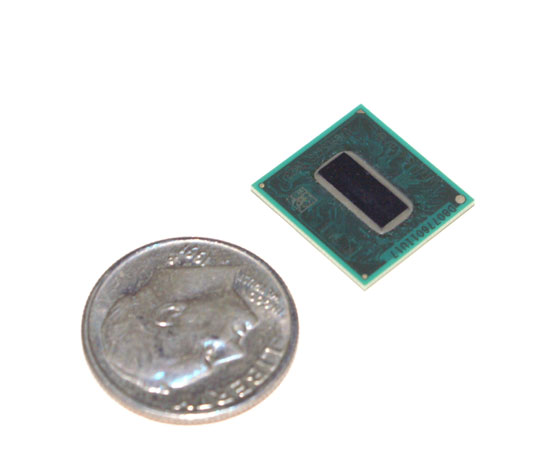
Oh, hai. You're bigger than I expected. You know, being called Atom and all.
Intel’s Atom processor is quite possibly Intel’s most important microarchitecture, yet it is hardly discussed - mostly because current implementations are hardly interesting. Today the Atom processor is little more than a very low power x86 chip that performs a lot like a 1.2GHz Pentium M, it’s not exactly setting any speed records.
We’ve already detailed the Atom architecture in depth here, to recap it’s a 2-issue, in-order architecture with SMT support. The goal for Atom has always been to be able to deliver the performance of a 4-year-old Pentium M, in a 1W power envelope. As we found in our initial performance investigation of Atom, Intel was able to sort of meet this goal. At 1.6GHz, the Atom performs somewhere between a 800MHz Pentium M and a 1.6GHz Pentium M - we roughly approximated that to be the performance of a 1.2GHz PM.
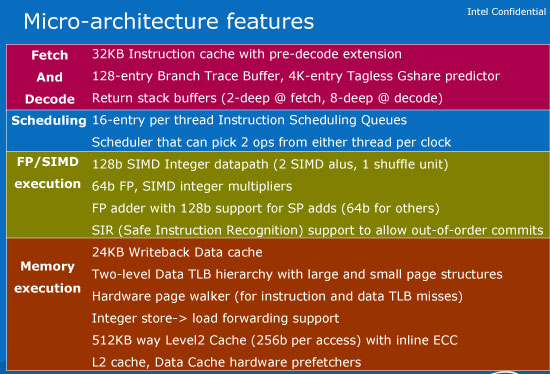
The problem is that at 1.6GHz, we’re at a 2W TDP. In order to drop below 1W we have to look at the 800MHz Atom Z500, which not only runs at half the clock speed but also lacks SMT support, which normally delivers a healthy performance increase on the in-order architecture.
So today Atom is hardly interesting beyond some niche markets. ASUS has embraced the chip for its Eee PC and Eee Box machines, but it’s either too slow for a real desktop, or too power hungry (and too large) for things like smartphones. You have to start somewhere though, and that’s what Atom is - a starting point. The next step is where things get more interesting...
Moorestown Recap and Update: 1B Transistors in your Pocket, in 5 Years
The Atom processor is just that, a standalone CPU. It has no integrated memory controller, much less on-die graphics or anything else that would make it feasible for use in something like a smartphone.
Atom’s mobile chipset counterpart, codenamed Poulsbo, is built on a very old 130nm manufacturing process, which unfortunately means that it’s huge:

The Intel Atom processor (left) vs. The Poulsbo chipset (right)
The physical size of the Atom/Poulsbo combination is just too large and the leakage power of the platform is too great to allow for multi-day standby battery life, which is necessary for something like a smartphone.
Intel’s answer comes by 2010 with Moorestown:
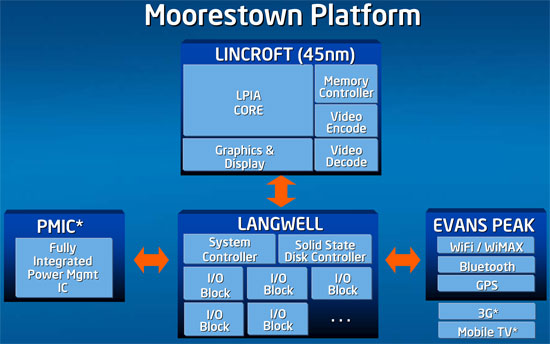
Moorestown is the System on a Chip (SoC) successor to Atom, addressing many of the deficiencies mentioned above. Built entirely on a 45nm process, Moorestown combines Atom with a memory controller, GPU and dedicated video encode/decode hardware. The new chip is called Lincroft and should boast reductions in physical size and power consumption, making it the first x86 platform ready for use in smartphones.
Intel revealed a bit more today about Moorestown, mostly highlighting the need for it.
Wireless bandwidth is increasing:
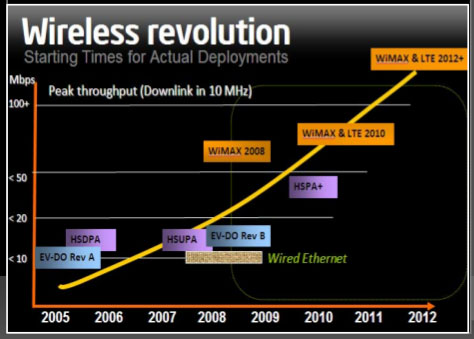
Just give me 10Mbps wirelessly by 2009 and I'll be happy
The types of things we’re trying to do online are also increasing in complexity:

Intel seems to imply that future SoCs will be made up of > 100M transistors, and it would be safe to say that the Lincroft chip in Moorestown could easily be a 100M transistor chip. The Atom processor itself is 47M transistors, integrating a memory controller, GPU and video encode/decode engines could easily see that balloon to 100M transistors.
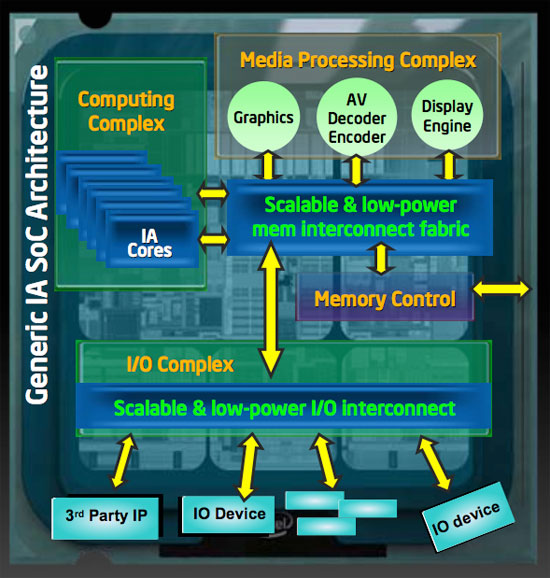
Even more exciting is that within 5 years Intel expects embedded processors like Lincroft to have 1 billion transistors. That would mean something with the complexity of Nehalem, in something the size of an iPhone...in 5 years.
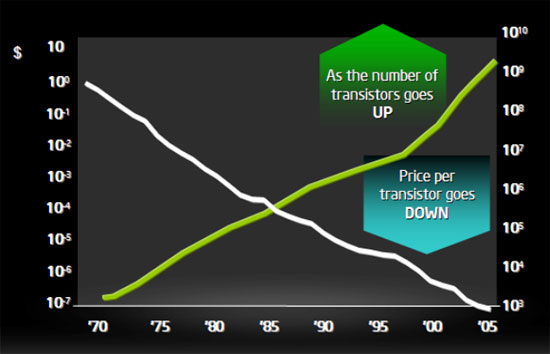
Moore's Law at its best. Not only do things get faster, less complex chips get much cheaper.
Highly Integrated x86 Today: EP80579
Intel also announced some of its Pentium M based embedded processor designs. The EP80579 series combines a Pentium M core, chipset and in some cases, specialized hardware to accelerate specific tasks on a single package:
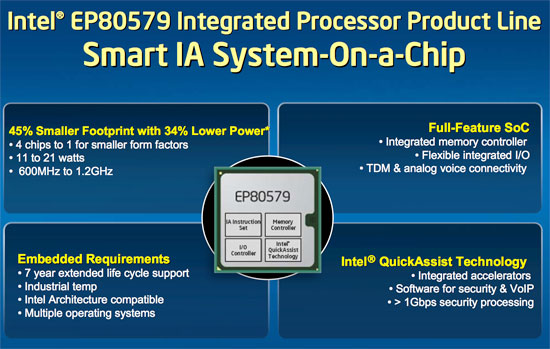
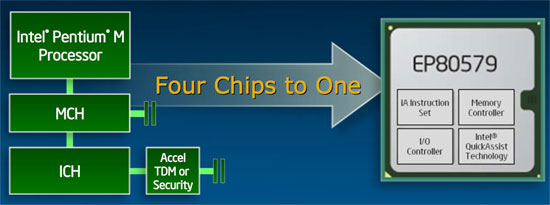
Intel’s also got x86 targeted at the consumer electronics market with its Canmore processor this year, and Sodaville next year. Details on these two chips is quite light, but it would seem that they are based on Atom designs. The sorts of CE devices they will be used in are things like Blu-ray players, Digital TVs and other settop boxes - where battery life isn’t really a concern.
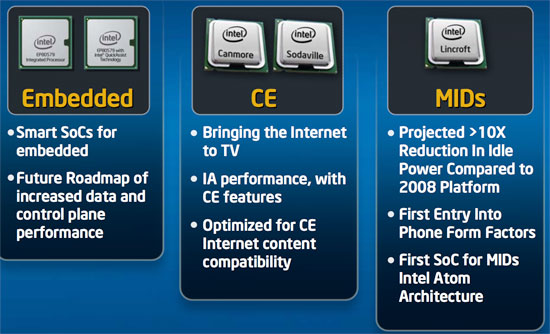
Intel: Bringing x86 to everything, including graphics...
All of Intel’s SoCs at this point are very crude designs, but they are a start. I doubt that there will be real excitement here until we see Moorestown and even then, it will take another couple of years before we see tremendous market penetration.
Intel is committed here, it’s just unusual writing about an aspect of the microprocessor industry where Intel is such a clear underdog. We may have to get used to this as next year is when Intel takes on the GPU industry with Larrabee...







